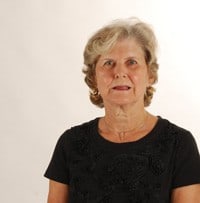Riding into Clear Vision
|  Before treatment at the UAMS Harvey & Bernice Jones Eye Institute, Carolyn Hopkins’ vision was so poor that she needed assistance doing ordinary tasks that most people take for granted. While she was comfortable in her home in Pine Bluff, she needed her husband’s assistance in the grocery store to find her way around the shelves of merchandise. When she attended to her grandchildren in their parents’ absence, Hopkins was not able to drive them to various activities and events.
Before treatment at the UAMS Harvey & Bernice Jones Eye Institute, Carolyn Hopkins’ vision was so poor that she needed assistance doing ordinary tasks that most people take for granted. While she was comfortable in her home in Pine Bluff, she needed her husband’s assistance in the grocery store to find her way around the shelves of merchandise. When she attended to her grandchildren in their parents’ absence, Hopkins was not able to drive them to various activities and events.
With poor vision caused by severe myopia (nearsightedness) from the time of birth, Hopkins began wearing glasses in the fourth grade. When she was 20 years old, she began wearing contacts. In an effort to see clearly, Hopkins had radial keratotomy (RK) surgery in 1991, which left 16 scars in each eye. Although the eye surgery provided better vision for a few years, Hopkins’ vision gradually worsened.
In 2009, Hopkins’ vision deterioration was so severe that it limited her activities, so Hopkins visited three different eye specialists. Searching for a way to improve her vision, she learned that she had dense cataracts, corneal scarring and macular degeneration, which was causing double vision. She also used eye drops to control her glaucoma.
Since other eye doctors were unable to provide any treatments to improve Hopkins’ vision, Hopkins was eventually referred to Joseph Chacko, M.D., at the UAMS Jones Eye Institute. Chacko performed surgery to remove Hopkins’ cataracts using phacoemulsification, breaking the cataracts into smaller pieces and then removing them. During the same surgery, Chacko also implanted intraocular lenses to correct the myopia, eliminating the need for Hopkins to wear contact lenses. Although inaccurate measurements are common with patients who have had RK surgery in the past, Chacko used the state-of-the-art Pentacam machine, which creates a 3D map of the eye, to ensure that Hopkins’ intraocular lenses were the correct strength to offer her the best vision.
“Every day is better,” Hopkins said. “I had almost stopped driving, but now I see and drive with much more confidence. And I’m also enjoying the little things, like watching television and seeing one moon instead of three when I look at the sky.”
Hopkins is now happy to enjoy all that her new vision has to offer, including line dancing and horseback riding. “I am so grateful, and I recommend Dr. Chacko and the UAMS Jones Eye Institute to anyone who has problems with their eyes.”